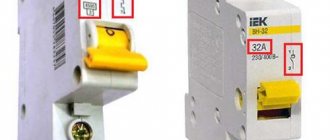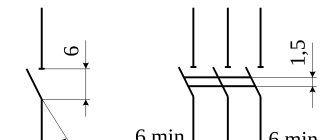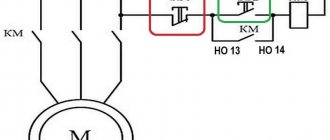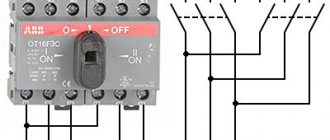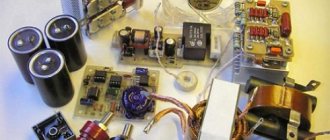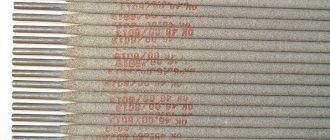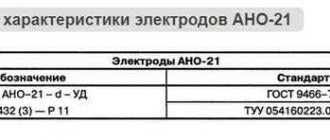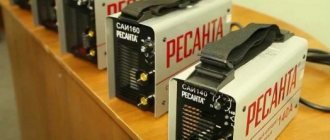5 / 5 ( 1 voice )
A reversing switch or switch in household electrical networks is usually used to connect backup power. These can be gasoline and diesel generators, as well as, for example, connecting a second source of electricity from another power line for reliable power supply to a private home. Switching is done mechanically in manual mode, do not confuse it with ATS (automatic transfer switching).
Because I mainly assemble electrical panels using ABB components, and I also use their reversible changeover switch. But it happens that I also install other switches, for example, “manual reserve input” from Legrand and SFT breaker switches from Hager, but I will write about this in separate articles.
When assembling electrical panels, I use ABB reversing load switches of 40A or 63A, depending on the power allocated for connecting a private house. There are also smaller ratings of 16 and 25 A, but they are very small and inconvenient to make switches with. To be honest, I don’t even know where they are used.
Often, when ordering electrical panels, you ask why you need to install a reversing switch , why you can’t just install a machine for the generator. The answer is very simple:
- Do not supply voltage to the general network , i.e. so that your generator does not become a source of electricity for the entire common power line. The neighbors, of course, will be happy with the electricity they receive from you, but at this time they may be fixing an accident on the line, and the electricians will come under voltage.
- The load transfer switch eliminates the possibility of back-to-back connection of two power sources , the main power supply from the power line and the backup one from the generator. The reversing switch eliminates the possibility of supplying voltage to the general network, or
Of course, theoretically, you can turn off the input circuit breaker or switch yourself, turn on your generator and use electricity from the generator. But who will give a 100% guarantee that one day you will not forget to turn off the input? Nobody, but as I wrote above, the reversing switch eliminates this. In simple words, this is “fool protection” .
The reversing switch has three positions:
- I ON – the left pole of the switch is on, while the right pole is off.
- О OFF – everything is disabled (both inputs).
- II ON – the right pole of the switch is turned on, while the left one is turned off.
The connection diagram for a backup generator to a changeover switch has several options depending on how many phases the generator is designed for. It also matters how many phases in the electrical panel at home you want to connect to the backup input.
Switches and switches
Switching devices for voltages up to 1000 V
Switching devices up to 1000 V are designed for switching electrical circuits in normal and emergency modes in single-, two- and three-phase AC networks with a frequency of 50 Hz and a rated voltage of 110, 220, 380 and 660 V.
Switching devices up to 1000 V include: circuit breakers and switches, fuses, contactors, magnetic starters and circuit breakers.
Switches and switches
Switches are designed for manually turning on and off electrical circuits of direct and alternating current with voltages up to 500 V inclusive and for rated currents up to 10,000 A [29].
The maximum current that a switch can turn off is usually less than the rated current. To increase the maximum switched current, switches are equipped with arcing chambers with arcing grids. In this case, the circuit breakers allow cutting off the current up to (1–1.25) I
nom.
A switch that is not equipped with a device for extinguishing the arc serves to relieve voltage - disconnecting the circuit without current and creating a visible break.
By design, there are one-, two- and three-pole switches.
The switches can be driven using a central handle, a side handle or remotely through a lever system. In installations for the auxiliary needs of power plants, switches with a manual lever drive are most widely used.
To reliably disconnect and protect the knives from burning, switches are made with momentary shutdown or with arc-extinguishing contacts. Instant shutdown is achieved using a torque knife connected by a spring to a parallel main knife. When disconnected, the main knife comes out first and stretches the spring. The speed of movement of the torque knife and the contact opening are determined by the parameters of the tripping spring. When using arc chutes, torque knives are usually not used.
Arcing contacts are used in DC switches at currents of more than 100 A and in all alternating current switches, where the speed of contact divergence and their solution have virtually no effect on the arc extinguishing conditions. These contacts are the last to be disconnected and serve to protect the main contacts from burning.
Extinguishing a DC arc (up to 75 A) occurs due to its mechanical stretching. At high currents, the arc is extinguished due to its movement by electrodynamic interaction forces. The shorter the knife, the greater the interaction force between the arc and the parts of the switch, which increases the switching capacity of the switch.
Rice. 4.9. Appearance of a switch with a protection function (switch-fuse) 250 V), which occurs when the current passes through zero. The length of the knife in alternating current switches is selected according to mechanical conditions. - Extinguishing the alternating current arc is carried out due to the near-cathode electrical strength (150
The use of arc chutes ensures that the arc is extinguished when the rated currents are switched off by 220 V DC and 380 V AC switches. At voltages of 440 and 500 V, the switched currents are 0.5 I
nom.
Switch-fuses are designed to turn on/off the load and protect against short circuits and overloads (Fig. 4.9).
Switch-fuses consist of the following parts:
- three-pole base equipped with spring contact jaws for connecting cables;
- bases with arc chutes and protective screen of lower contacts;
- removable block handle with space for fusible inserts.
Switches are designed to switch electrical circuits.
Packet switches are small in size and easy to install; When switching, the release of flame and gases is eliminated. The contact system allows you to control a large number of circuits simultaneously. Such switches allow switching off rated currents.
Batch switches do not provide a visible circuit break, so in some circuits it is necessary to install switches.
Switching devices for voltages up to 1000 V
Switching devices up to 1000 V are designed for switching electrical circuits in normal and emergency modes in single-, two- and three-phase AC networks with a frequency of 50 Hz and a rated voltage of 110, 220, 380 and 660 V.
Switching devices up to 1000 V include: circuit breakers and switches, fuses, contactors, magnetic starters and circuit breakers.
Switches and switches
Switches are designed for manually turning on and off electrical circuits of direct and alternating current with voltages up to 500 V inclusive and for rated currents up to 10,000 A [29].
The maximum current that a switch can turn off is usually less than the rated current. To increase the maximum switched current, switches are equipped with arcing chambers with arcing grids. In this case, the circuit breakers allow cutting off the current up to (1–1.25) I
nom.
A switch that is not equipped with a device for extinguishing the arc serves to relieve voltage - disconnecting the circuit without current and creating a visible break.
By design, there are one-, two- and three-pole switches.
The switches can be driven using a central handle, a side handle or remotely through a lever system. In installations for the auxiliary needs of power plants, switches with a manual lever drive are most widely used.
To reliably disconnect and protect the knives from burning, switches are made with momentary shutdown or with arc-extinguishing contacts. Instant shutdown is achieved using a torque knife connected by a spring to a parallel main knife. When disconnected, the main knife comes out first and stretches the spring. The speed of movement of the torque knife and the contact opening are determined by the parameters of the tripping spring. When using arc chutes, torque knives are usually not used.
Arcing contacts are used in DC switches at currents of more than 100 A and in all alternating current switches, where the speed of contact divergence and their solution have virtually no effect on the arc extinguishing conditions. These contacts are the last to be disconnected and serve to protect the main contacts from burning.
Extinguishing a DC arc (up to 75 A) occurs due to its mechanical stretching. At high currents, the arc is extinguished due to its movement by electrodynamic interaction forces. The shorter the knife, the greater the interaction force between the arc and the parts of the switch, which increases the switching capacity of the switch.
Rice. 4.9. Appearance of a switch with a protection function (switch-fuse) 250 V), which occurs when the current passes through zero. The length of the knife in alternating current switches is selected according to mechanical conditions. - Extinguishing the alternating current arc is carried out due to the near-cathode electrical strength (150
The use of arc chutes ensures that the arc is extinguished when the rated currents are switched off by 220 V DC and 380 V AC switches. At voltages of 440 and 500 V, the switched currents are 0.5 I
nom.
Switch-fuses are designed to turn on/off the load and protect against short circuits and overloads (Fig. 4.9).
Switch-fuses consist of the following parts:
- three-pole base equipped with spring contact jaws for connecting cables;
- bases with arc chutes and protective screen of lower contacts;
- removable block handle with space for fusible inserts.
Switches are designed to switch electrical circuits.
Packet switches are small in size and easy to install; When switching, the release of flame and gases is eliminated. The contact system allows you to control a large number of circuits simultaneously. Such switches allow switching off rated currents.
Batch switches do not provide a visible circuit break, so in some circuits it is necessary to install switches.
